#red-eyed tree frog
Photo
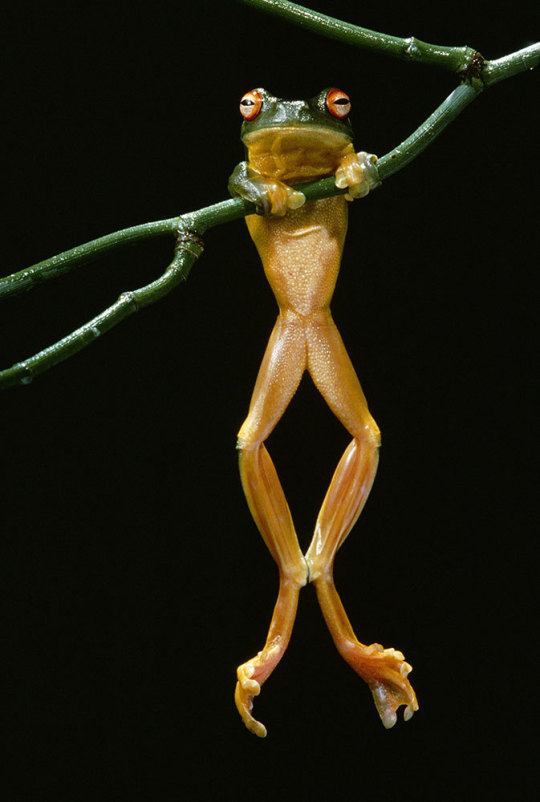
A red-eyed tree frog clutches a branch in a rainforest in Australia. Frogs are challenged by the climate crisis, pollution, and a deadly fungus—exacerbated by Europe's demand for their legs. Conservationists say the EU should do more to help regulate the trade and protect species.
SCIENCE SOURCE
#science source#photographer#national geographic#red-eyed tree frog#frog#rainforest#australia#animal#amphibian#nature
521 notes
·
View notes
Text
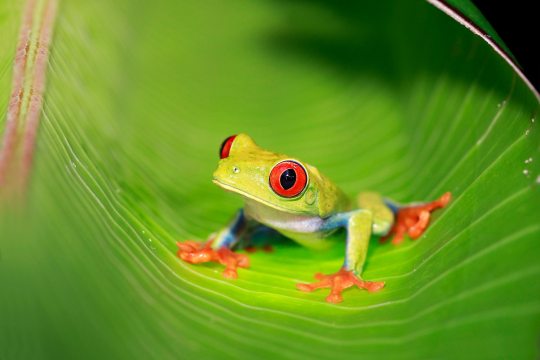


Keep Your Eye on the Red-Eyed Tree Frog
A striking specimen of frog, the red-eyed tree frog (Agalychnis callidryas) is found in the tropical regions of Central and South America, from southern Mexico to northern Columbia. Its primary habitat are rainforests, but they can also be found in wetlands or mangroves- anywhere with abundant water and high humidity.
Though small-- between 4-7 cm (1.57 -2.76 in) long and less than 15 g (0.53 oz)-- the red-eyed tree frog is well known for its bright, distinctive coloration. The body is bright green, with cream bellies and light blue streaks along the sides and hind legs. These features help individuals blend in to the leaves they rest on, while still being able to startle predators with bright colors when threatened. Likewise, the eyes are a vivid red which gives A. callidryas its common name. Even when its eyes are closed, this species has a distinctive look; rather than true eyelids, they have a semi-translucent eyelid called a nictating membrane that allows them to sense when potential predators are approaching.
Adults and juveniles alike face many threats due to their small size. Eggs are a popular food for polybid wasps and snakes, while hatchlings are more commonly predated upon by shrimp and large fish. Mature adults become food for aquatic spiders, snakes, birds, and bats. However, the skin of A. callidryas contains several mild poisons that serve to deter predators through a foul taste. The red-eyed tree frog itself is a nocturnal carnivore, consuming primarily insects and the occasional tadpole. This species spends most of its life in the trees, and rarely descends to the ground.
Red-eyed tree frogs mate during the rainy season, from October to March. Males call loudly to attract females, and wrestle each other for primary access; females are attracted to males with the loudest calls, but must often face a gauntlet of lesser males attempting to mate with her before she can reach her target. Some males may also shake the branches they sit on to detach rival males; this vibration is especially attractive to females. Following successful mating, the female lays about 40 eggs on the underside of a leaf overhanging a small body of water.
Eggs typically hatch 6 or 7 days after being laid, and hatchling drop from the leaf into the water below. A. callidryas spends about 45 days as a tadpole, after which time they emerge from the water and move upwards to begin their lives in the trees. Young red-eyed tree frogs don't become fully mature for another two years in the wild, but may not begin mating for another two years; because they only live about 5 years in the wild, this means that individuals may only mate once or twice in their lifetimes.
Conservation status: Currently the red-eyed tree frog is considered Least Concern by the IUCN. However, populations are decreasing at a rapid rate due to a combination of threats including deforestation, capture for the pet trade, and a highly infectious disease known as chytrid fungus.
If you like what I do, consider leaving a tip or buying me a ko-fi!
Megan Lorenz
Juan Gabriel Abarca
Brian Gratwicke via iNaturalist
#red-eyed tree frog#Anura#Hylidae#tree frogs#frogs#amphibians#tropical fauna#tropical amphibians#tropical rainforests#tropical rainforest amphibians#wetlands#wetland amphibians#central america#south america#biology#zoology#animal facts
83 notes
·
View notes
Text
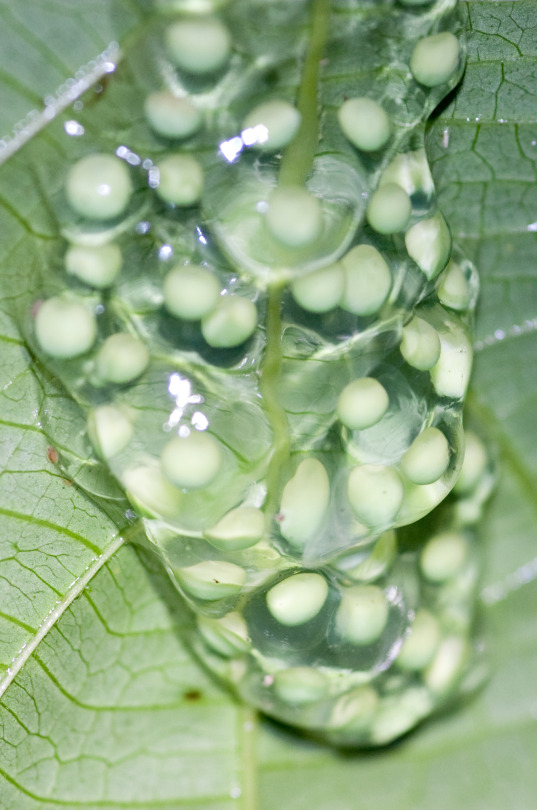
Red-eyed Tree Frog (Agalychnis callidryas) eggs
41 notes
·
View notes
Text

Eye of Red-eyed Tree Frog (Agalychnis callidryas)
Photo by Ingo Arndt
#agalychnis#agalychnis callidryas#tree frog#frog#red-eyed tree frog#amphibians#green#green and red#red and green#macro photography#frog photography#nature#animals#wildlife#tropical#tropical animals#tropical frogs
63 notes
·
View notes
Text

Bamboo baby little frog baby :)
10 notes
·
View notes
Text

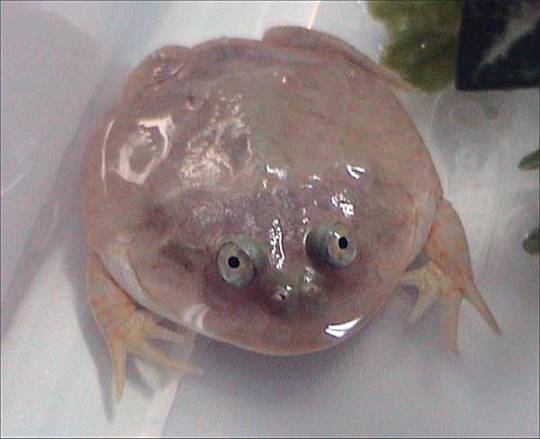
Red-Eyed Tree Frog: This species is best known for its striking colouration, which changes throughout their range. Individuals from the Northern end of their range in Mexico average 5 bars on their sides, while those from Panama average 9 bars. Froglets are able to change colour, and even their eggs are able to adapt to environmental conditions. If they sense a danger such as a snake, predatory wasp, or fungus, tadpoles can choose to immediately hatch and drop from the leaf on which the eggs are laid into the water below. (video) Which eggs hatch is chosen based on the source of the danger and can occur as soon as four days after the eggs are laid. Normally, eggs from a clutch hatch asynchronously approximately a week after fertilization, and tadpoles which fall out of the water can survive up to 20 hours. Males use the same vibrational sensing that the eggs do in territorial disputes, where they shake the branch they are on before wrestling.
Budgett's Frog: These South American frogs overwinter in underground burrows, where they hide in a cocoon of hardened skin to keep moist. An aggressive species, their tadpoles have nearly adult jaws, which they use to swallow their prey (sometimes other tadpoles) whole. As for adults, they puff up and screech loudly when threatened, going as far as to attack and bite the perceived danger. Males also have a dark blue throat (not visible in the image,) and all members of the species have a spade-like “tubercle” on their back legs that helps them dig.
11 notes
·
View notes
Text
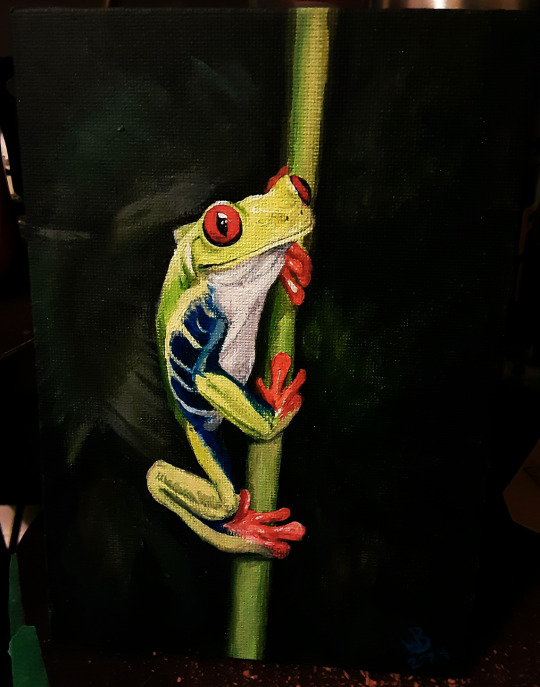
I need to take a daytime picture of this because this boy is BRIGHT
acrylics on canvasboard
9 notes
·
View notes
Text


#red eyed tree frog#memes#meme#frog memes#frog meme#dad jokes#funny memes#frogs#frog#amphibian#amphibians#red-eyed tree frog
128 notes
·
View notes
Photo
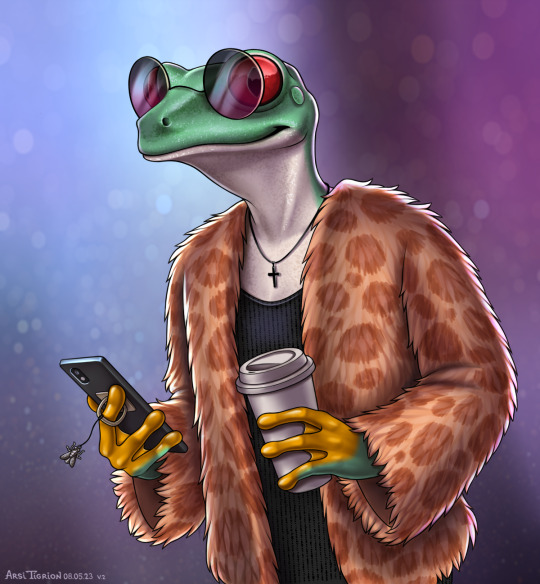
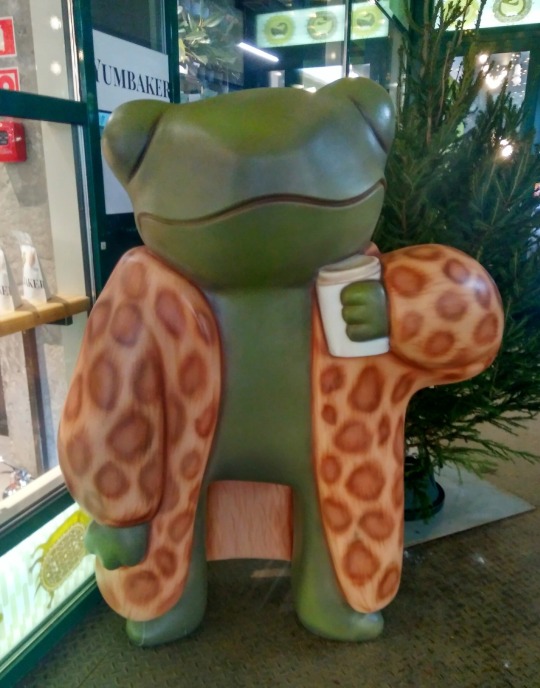
This is the second version of the frog that I drew earlier. I decided to add maximum brightness and color! :D
Last fall I was passing by that cafe and saw that they have a second frog in a spotted fur coat! I couldn't help myself.
► Look the first froggy! ◄
11 notes
·
View notes
Text
Animal of the Day!
Red-eyed Tree Frog (Agalychnis callidryas)

(Photo fromGeoff Gallice)
Conservation Status- Least Concern
Habitat- Central America; South America
Size (Weight/Length)- 7.6 cm
Diet- Small insects
Cool Facts- Red-eyed tree frogs almost never set foot on the ground in their entire lives. Instead, they spend their days in tree canopies, using their coloration to blend in with leaves by tucking their feet under their bodies and closing their eyes. Being nocturnal, they have excellent night vision that gives them an advantage over crickets and moths. After mating, female red-eyed tree frogs lay their eggs on leaves over ponds so that the tadpoles will drop into the water after hatching. However, if one egg senses another is being eaten by a predator, the tadpole can greatly increase its growth to drop into the water before being eaten up to two days before it would have naturally hatched.
Rating- 13/10 (The most iconic frog. Need I say more?)
#Animal of the day#Animals#Frogs#Amphibians#Friday#September 23#Red-eyed tree frog#biology#science#conservation#the more you know
52 notes
·
View notes
Text
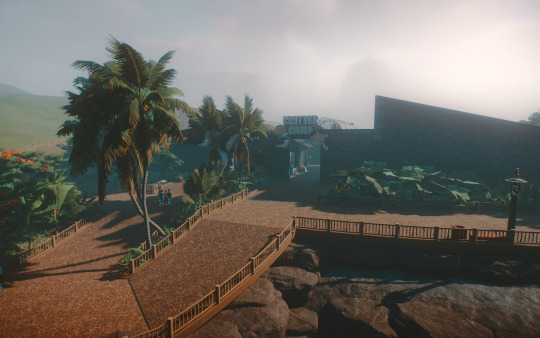






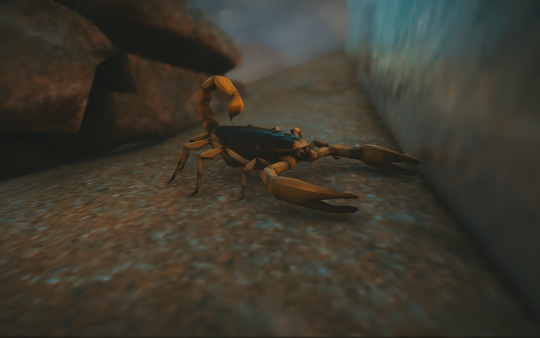

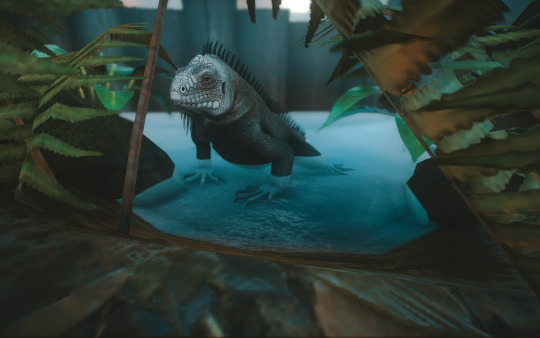


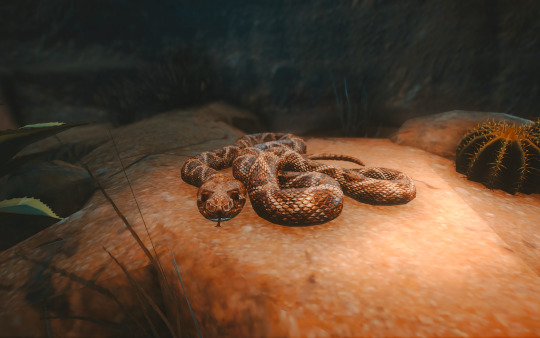

lots of exhibit animals
#zooposting#planet zoo#pacific winds#american bullfrog#axolotl#diamondback terrapin#giant desert hairy scorpion#gila monster#lesser antillean iguana#red-eyed tree frog#western diamondback rattlesnake#i love the iguanas they look so good <3#reshade
10 notes
·
View notes
Photo

RED-EYED TREE FROG
SPECIAL SHIELD: The red-eyed tree frog has a see-through eyelid with a striped pattern. The lid protects the frog’s eyes underwater and keeps them moist on land in Central America.
PHOTOGRAPH BY THOMAS MARENT, MINDEN PICTURES
647 notes
·
View notes
Text
Pick a Pet.
So! I have a 4x45x60cm (18x18x24″) bioactive terrarium awaiting a resident.
I was initially going to get dart frogs, but I just can’t stand handling the fruit flies anymore. I can’t do it. I CAN’T!
So now I’m turning to other options.
I already have a peacock day gecko, pacman frog, three stenodactylus sthenodactylus, and a number of tarantulas. I’ll be getting some mourning geckos as well once the small terrarium is finished.
I’m planning on getting a cuban false chameleon for a second terrarium I have; this is a guy I’ll be able to handle, if I want, so the other resident doesn’t need to be handleable.
Handling isn’t that important to me, I know a lot of reptiles don’t like it.
Likewise, I’m not interested in breeding. If it happens, it happens, otherwise I’m not bothered.
Diet wise, I already feed dubia roaches and crickets to my current animals, and I’ll be getting snails for my false chameleon, so I’m not too leery about feeder insects, except for fruit flies, who are the bane of my life. NO FRUIT FLIES.
Maintenance-wise, I’ll be setting up an automatic misting system, and the terrariums will be bioactive so they’ll have clean up crews for the majority of the mess.
Nominees are:
TOKAY GECKO

Pros: top of my list, unique looking, personality, feisty, easy to feed, not too expensive
Cons: defensive/aggressive, might be hard to wrangle, nocturnal ?
I’m probably going to go with this option. Tokay’s are notorious for being unhandleable, but handleability isn’t on my list of requirements, so I don’t care. A nice contrast to the false chameleon?
MADAGASCAN DAY GECKO
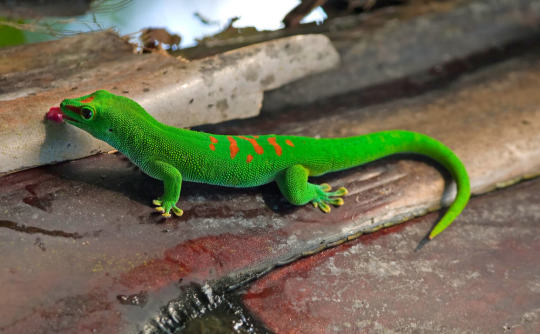
Pros: cute as hell, large and attractive, pretty, personable, curious, diurnal, very easy to feed (powder foods), can be trained to climb onto your hand
Cons: already have a day gecko, a little more costly, not handleable because they can drop their tails but also SLOUGH OFF THEIR SKIN NO NO
If I had an extra terrarium I’d get one, but dudes, the skin. THE SKIN. I can’t take it, I’d never want to hurt an animal and I can’t stand the idea of accidentally causing this. Also very similar to my existing peacock gecko
CHAHOUA GECKO

Pros: easy care, basically a big version of a crested gecko, handleable, unusual and I think they’re pretty
Cons: SO expensive, on this list by a tenuous grasp because of that, not as drawn to them as the above two, EXPENSIVE, costs money, I’m poor and this gecko is expensive, did I mention expensive?
We’re talking £300 to £500 for a pair; they’re also hard to find NOT in a pair, for some reason.
RED-EYED TREE FROG

Pros: frog!, very pretty, unique, fun to have, doesn’t eat fruit flies, sweet, appeal of another frog
Cons: small in an enclosure (I can’t remember if you can keep a pair or trio together), hides, mid-pricey, I’m not as drawn to them as the top two geckos
Close to my original dart frog idea, but they don’t need to eat fruit flies. A classic amphibian, but I’m not sure I want another one. Would it be better to keep to geckos?
Looking forward to seeing your opinions!
POLL HERE
#polls#frog#gecko#tokay gecko#madagascan giant day gecko#giant day gecko#chahoua gecko#red-eyed tree frog#reptiles#reptiblr#amphibians
3 notes
·
View notes
Photo
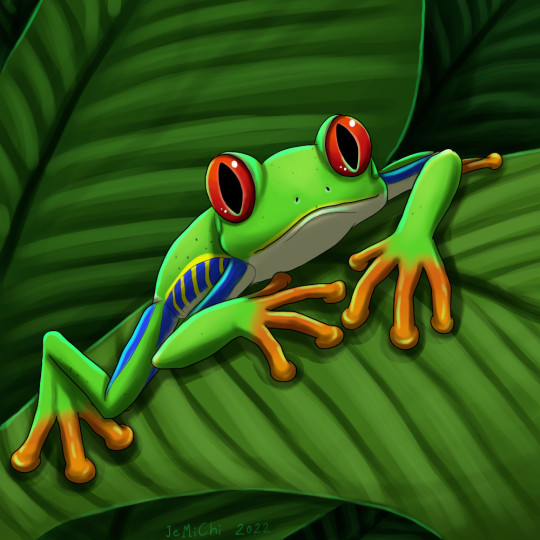

Posting some amphibians today because I haven't been drawing frogs or salamanders in a long time and that needed to be fixed! Featuring a Red-eyed Tree Frog and an Axolotl. ^^
3 notes
·
View notes
Text

Red-eyed tree frog at La Paz Waterfall, Costa Rica
Stephanie LeBlanc
Scientific name: Agalychnis callidryas
Conservation status: Least Concern (Population decreasing)
Lifespan in captivity: about 8-12 years
Class: Amphibia
Domain: Eukaryota
Family: Hylidae
Genus: Agalychnis
Habitat: Lowland tropical rainforests with high humidity and warm daytime and nighttime temperatures, often near a river or water source.
Range: Found in tropical lowlands from southern Mexico, throughout Central America, and in northern South America
Diet: Carnivores. This nocturnal carnivore feeds primarily at night on insects, including: grasshoppers, flies, moths and crickets. The Red-Eyed Tree Frog eats anything it can fit in its mouth, even smaller frogs.
Lifespan: About 5 year in the wild and 8-12 years under human care
#La Paz Waterfall#Costa Rica#South America#Red-eyed tree frog#red eyed tree frog#Frog#Frogs#Wildlife#CostaRicaWildlife
1 note
·
View note
Text


Cha! Cha! the red-eyed tree frog from Rainforest Cafe (1996)
0 notes